Assessment 2: Effective Business Communication - Intercultural Challenges at BeautyPro
VerifiedAdded on 2024/07/01
|14
|4994
|488
AI Summary
This report analyzes the intercultural challenges faced by BeautyPro, a company expanding into the Chinese market. It examines the impact of different cultural values and etiquette, direct versus indirect communication styles, and cultural norms of decision-making. The report provides recommendations for addressing these challenges and fostering effective communication within a multicultural environment.
Contribute Materials
Your contribution can guide someone’s learning journey. Share your
documents today.
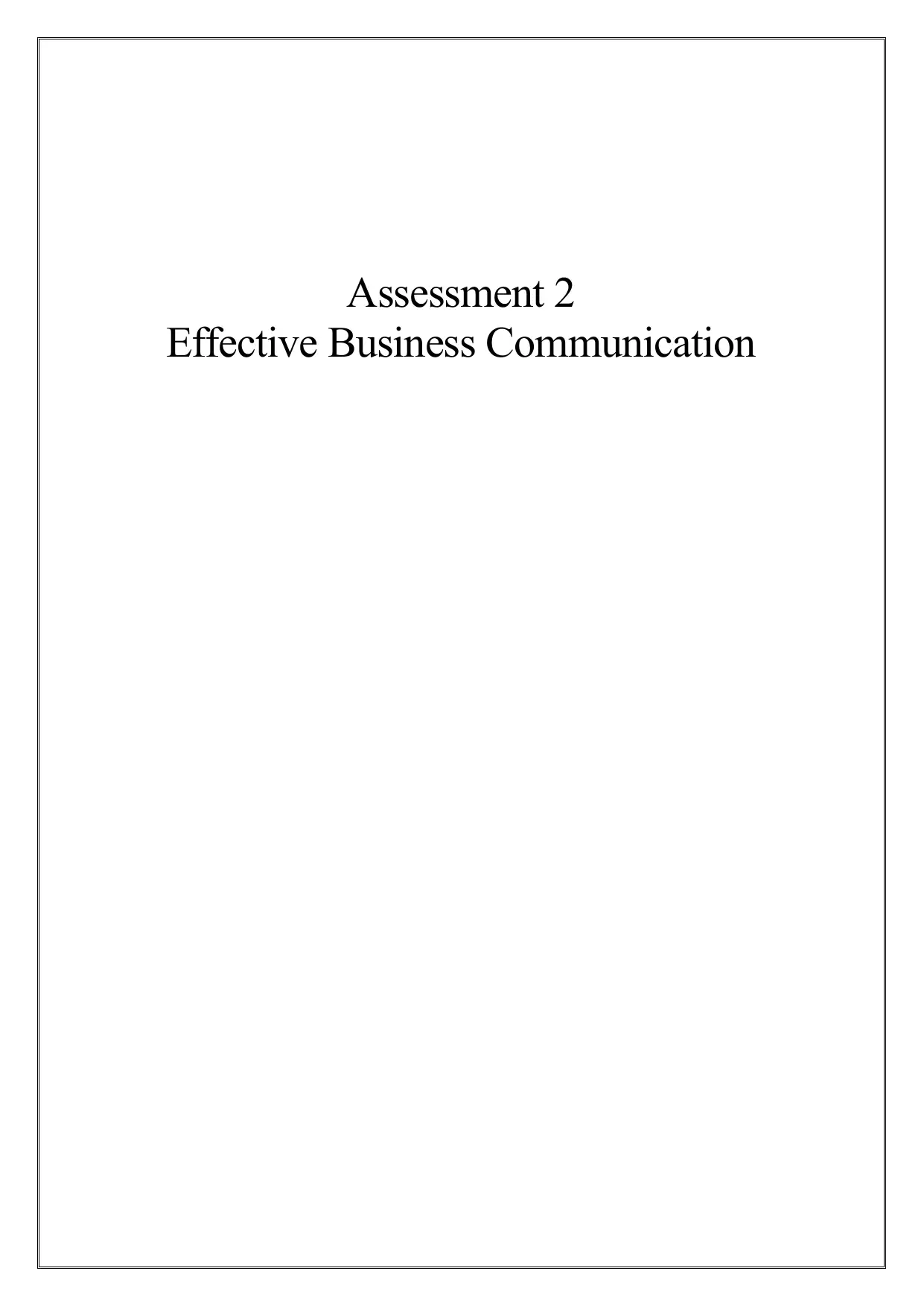
Assessment 2
Effective Business Communication
Effective Business Communication
Secure Best Marks with AI Grader
Need help grading? Try our AI Grader for instant feedback on your assignments.
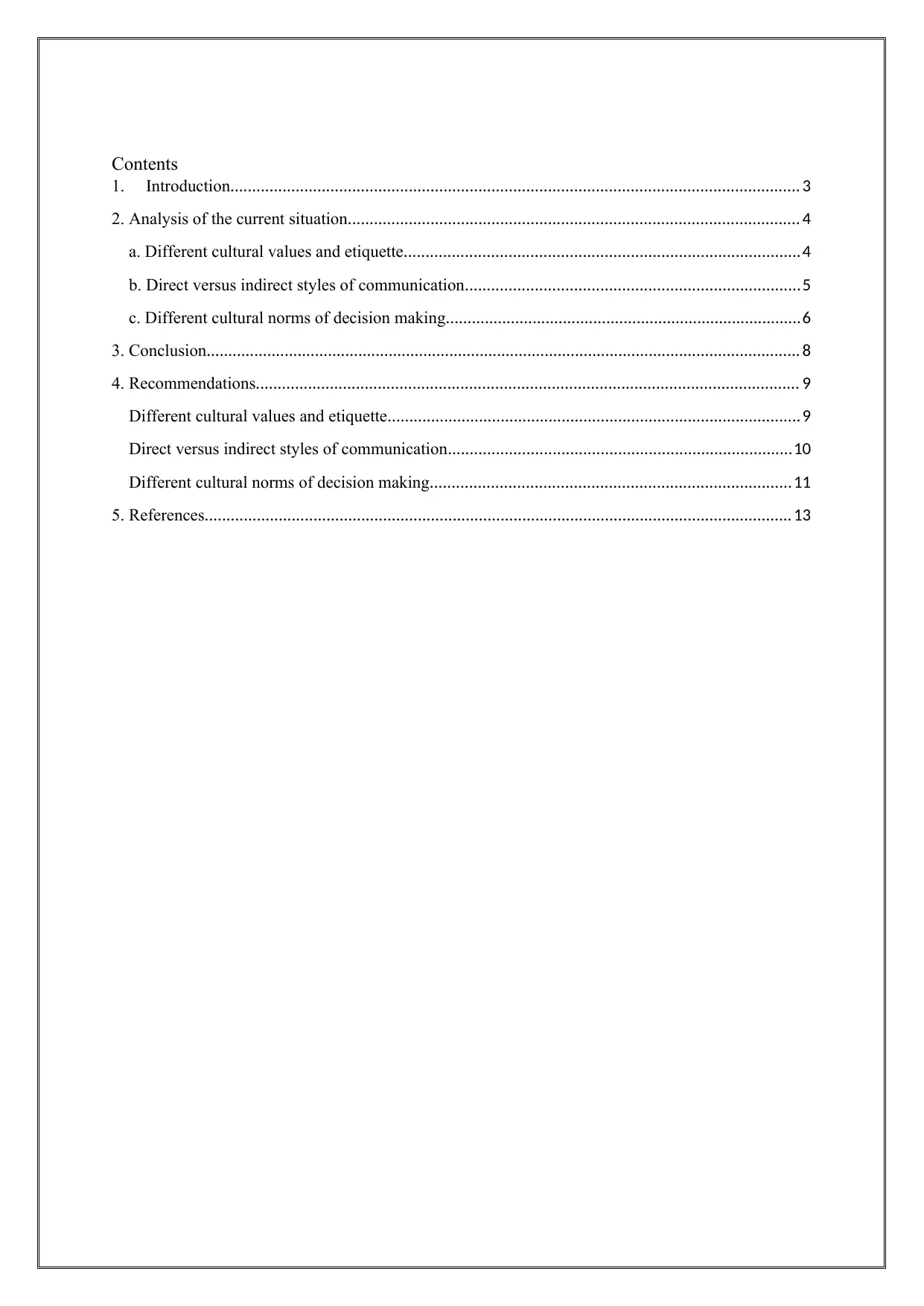
Contents
1. Introduction................................................................................................................................... 3
2. Analysis of the current situation........................................................................................................ 4
a. Different cultural values and etiquette...........................................................................................4
b. Direct versus indirect styles of communication.............................................................................5
c. Different cultural norms of decision making..................................................................................6
3. Conclusion......................................................................................................................................... 8
4. Recommendations............................................................................................................................. 9
Different cultural values and etiquette...............................................................................................9
Direct versus indirect styles of communication...............................................................................10
Different cultural norms of decision making...................................................................................11
5. References....................................................................................................................................... 13
1. Introduction................................................................................................................................... 3
2. Analysis of the current situation........................................................................................................ 4
a. Different cultural values and etiquette...........................................................................................4
b. Direct versus indirect styles of communication.............................................................................5
c. Different cultural norms of decision making..................................................................................6
3. Conclusion......................................................................................................................................... 8
4. Recommendations............................................................................................................................. 9
Different cultural values and etiquette...............................................................................................9
Direct versus indirect styles of communication...............................................................................10
Different cultural norms of decision making...................................................................................11
5. References....................................................................................................................................... 13
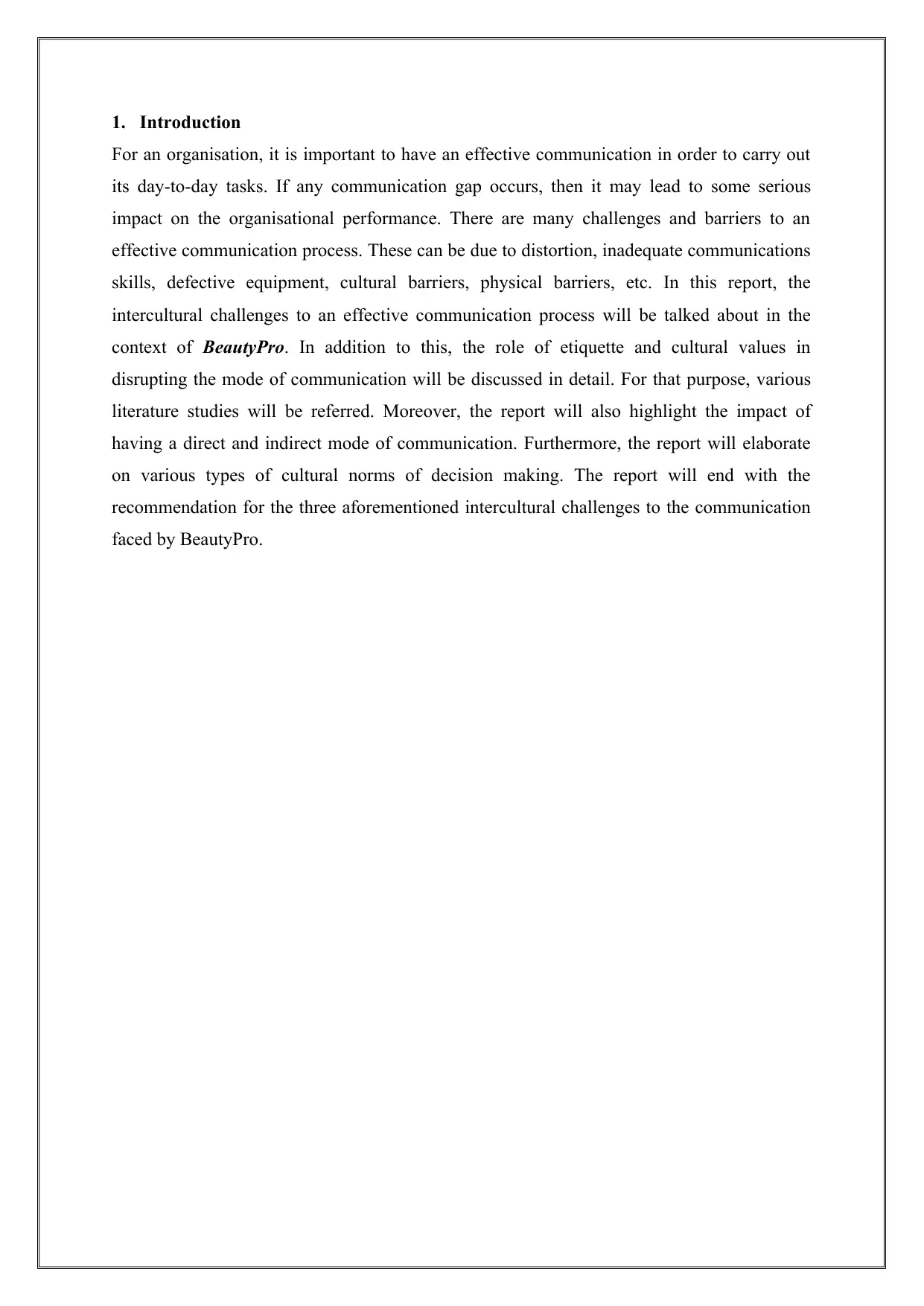
1. Introduction
For an organisation, it is important to have an effective communication in order to carry out
its day-to-day tasks. If any communication gap occurs, then it may lead to some serious
impact on the organisational performance. There are many challenges and barriers to an
effective communication process. These can be due to distortion, inadequate communications
skills, defective equipment, cultural barriers, physical barriers, etc. In this report, the
intercultural challenges to an effective communication process will be talked about in the
context of BeautyPro. In addition to this, the role of etiquette and cultural values in
disrupting the mode of communication will be discussed in detail. For that purpose, various
literature studies will be referred. Moreover, the report will also highlight the impact of
having a direct and indirect mode of communication. Furthermore, the report will elaborate
on various types of cultural norms of decision making. The report will end with the
recommendation for the three aforementioned intercultural challenges to the communication
faced by BeautyPro.
For an organisation, it is important to have an effective communication in order to carry out
its day-to-day tasks. If any communication gap occurs, then it may lead to some serious
impact on the organisational performance. There are many challenges and barriers to an
effective communication process. These can be due to distortion, inadequate communications
skills, defective equipment, cultural barriers, physical barriers, etc. In this report, the
intercultural challenges to an effective communication process will be talked about in the
context of BeautyPro. In addition to this, the role of etiquette and cultural values in
disrupting the mode of communication will be discussed in detail. For that purpose, various
literature studies will be referred. Moreover, the report will also highlight the impact of
having a direct and indirect mode of communication. Furthermore, the report will elaborate
on various types of cultural norms of decision making. The report will end with the
recommendation for the three aforementioned intercultural challenges to the communication
faced by BeautyPro.
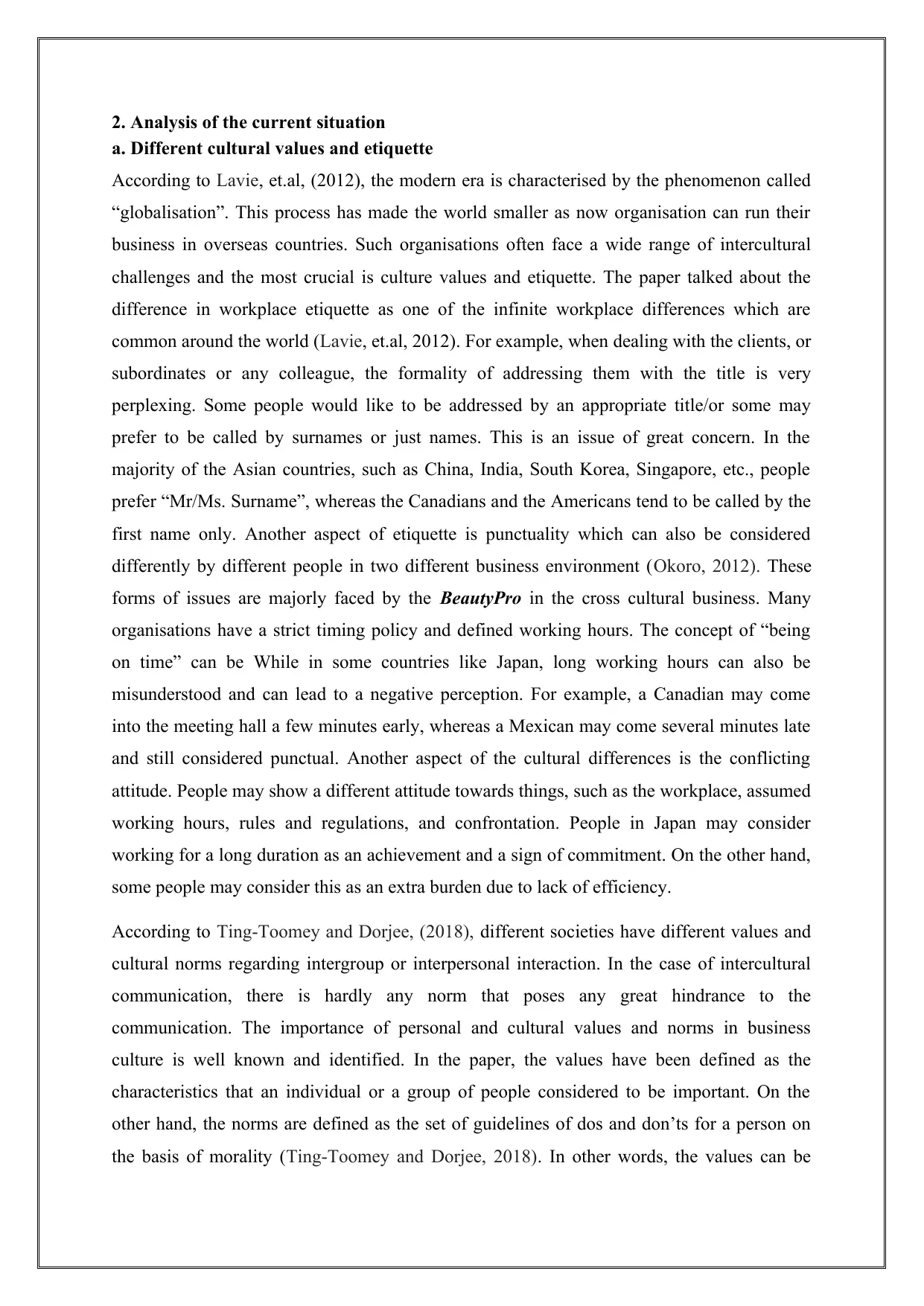
2. Analysis of the current situation
a. Different cultural values and etiquette
According to Lavie, et.al, (2012), the modern era is characterised by the phenomenon called
“globalisation”. This process has made the world smaller as now organisation can run their
business in overseas countries. Such organisations often face a wide range of intercultural
challenges and the most crucial is culture values and etiquette. The paper talked about the
difference in workplace etiquette as one of the infinite workplace differences which are
common around the world (Lavie, et.al, 2012). For example, when dealing with the clients, or
subordinates or any colleague, the formality of addressing them with the title is very
perplexing. Some people would like to be addressed by an appropriate title/or some may
prefer to be called by surnames or just names. This is an issue of great concern. In the
majority of the Asian countries, such as China, India, South Korea, Singapore, etc., people
prefer “Mr/Ms. Surname”, whereas the Canadians and the Americans tend to be called by the
first name only. Another aspect of etiquette is punctuality which can also be considered
differently by different people in two different business environment (Okoro, 2012). These
forms of issues are majorly faced by the BeautyPro in the cross cultural business. Many
organisations have a strict timing policy and defined working hours. The concept of “being
on time” can be While in some countries like Japan, long working hours can also be
misunderstood and can lead to a negative perception. For example, a Canadian may come
into the meeting hall a few minutes early, whereas a Mexican may come several minutes late
and still considered punctual. Another aspect of the cultural differences is the conflicting
attitude. People may show a different attitude towards things, such as the workplace, assumed
working hours, rules and regulations, and confrontation. People in Japan may consider
working for a long duration as an achievement and a sign of commitment. On the other hand,
some people may consider this as an extra burden due to lack of efficiency.
According to Ting-Toomey and Dorjee, (2018), different societies have different values and
cultural norms regarding intergroup or interpersonal interaction. In the case of intercultural
communication, there is hardly any norm that poses any great hindrance to the
communication. The importance of personal and cultural values and norms in business
culture is well known and identified. In the paper, the values have been defined as the
characteristics that an individual or a group of people considered to be important. On the
other hand, the norms are defined as the set of guidelines of dos and don’ts for a person on
the basis of morality (Ting-Toomey and Dorjee, 2018). In other words, the values can be
a. Different cultural values and etiquette
According to Lavie, et.al, (2012), the modern era is characterised by the phenomenon called
“globalisation”. This process has made the world smaller as now organisation can run their
business in overseas countries. Such organisations often face a wide range of intercultural
challenges and the most crucial is culture values and etiquette. The paper talked about the
difference in workplace etiquette as one of the infinite workplace differences which are
common around the world (Lavie, et.al, 2012). For example, when dealing with the clients, or
subordinates or any colleague, the formality of addressing them with the title is very
perplexing. Some people would like to be addressed by an appropriate title/or some may
prefer to be called by surnames or just names. This is an issue of great concern. In the
majority of the Asian countries, such as China, India, South Korea, Singapore, etc., people
prefer “Mr/Ms. Surname”, whereas the Canadians and the Americans tend to be called by the
first name only. Another aspect of etiquette is punctuality which can also be considered
differently by different people in two different business environment (Okoro, 2012). These
forms of issues are majorly faced by the BeautyPro in the cross cultural business. Many
organisations have a strict timing policy and defined working hours. The concept of “being
on time” can be While in some countries like Japan, long working hours can also be
misunderstood and can lead to a negative perception. For example, a Canadian may come
into the meeting hall a few minutes early, whereas a Mexican may come several minutes late
and still considered punctual. Another aspect of the cultural differences is the conflicting
attitude. People may show a different attitude towards things, such as the workplace, assumed
working hours, rules and regulations, and confrontation. People in Japan may consider
working for a long duration as an achievement and a sign of commitment. On the other hand,
some people may consider this as an extra burden due to lack of efficiency.
According to Ting-Toomey and Dorjee, (2018), different societies have different values and
cultural norms regarding intergroup or interpersonal interaction. In the case of intercultural
communication, there is hardly any norm that poses any great hindrance to the
communication. The importance of personal and cultural values and norms in business
culture is well known and identified. In the paper, the values have been defined as the
characteristics that an individual or a group of people considered to be important. On the
other hand, the norms are defined as the set of guidelines of dos and don’ts for a person on
the basis of morality (Ting-Toomey and Dorjee, 2018). In other words, the values can be
Secure Best Marks with AI Grader
Need help grading? Try our AI Grader for instant feedback on your assignments.
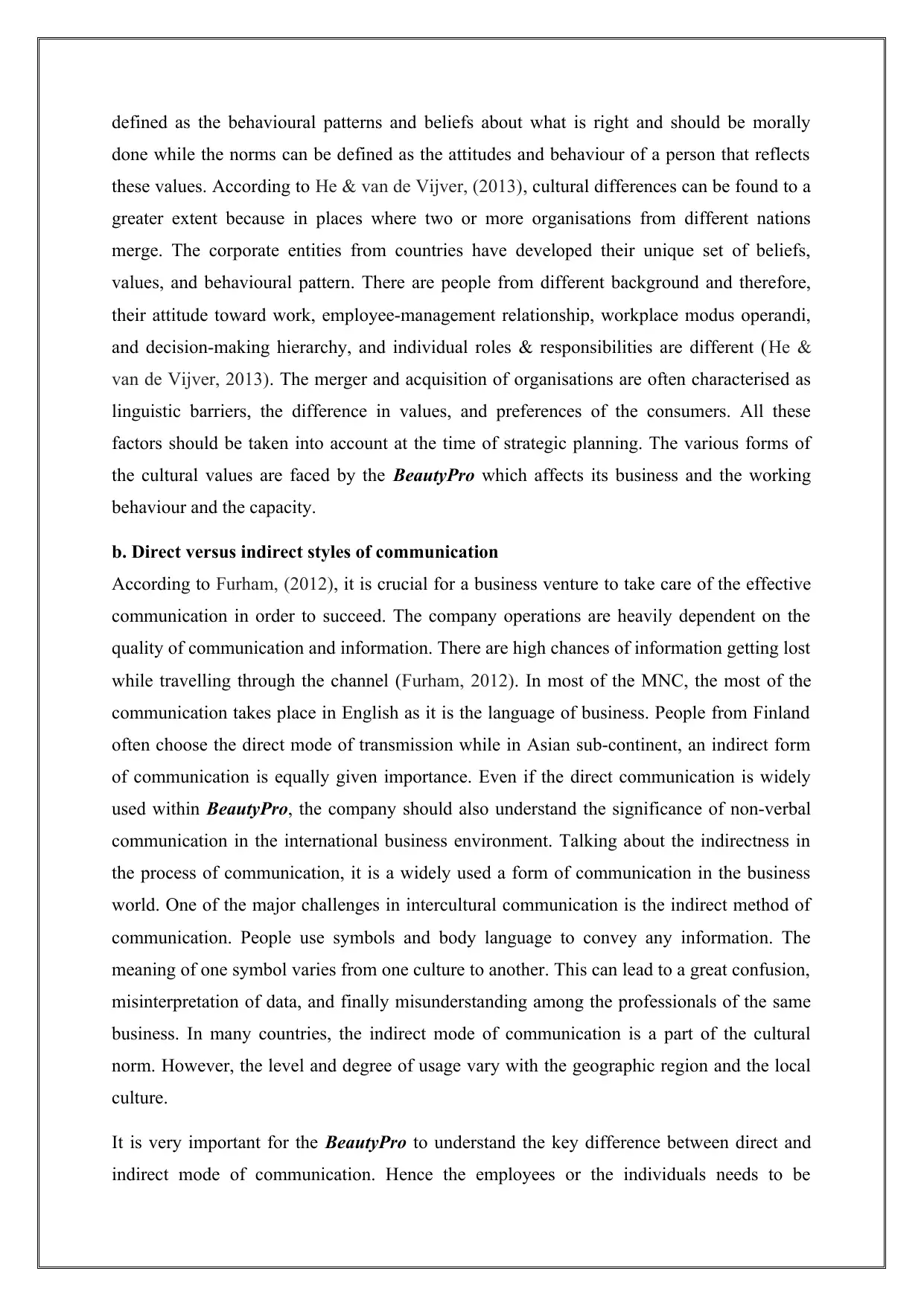
defined as the behavioural patterns and beliefs about what is right and should be morally
done while the norms can be defined as the attitudes and behaviour of a person that reflects
these values. According to He & van de Vijver, (2013), cultural differences can be found to a
greater extent because in places where two or more organisations from different nations
merge. The corporate entities from countries have developed their unique set of beliefs,
values, and behavioural pattern. There are people from different background and therefore,
their attitude toward work, employee-management relationship, workplace modus operandi,
and decision-making hierarchy, and individual roles & responsibilities are different (He &
van de Vijver, 2013). The merger and acquisition of organisations are often characterised as
linguistic barriers, the difference in values, and preferences of the consumers. All these
factors should be taken into account at the time of strategic planning. The various forms of
the cultural values are faced by the BeautyPro which affects its business and the working
behaviour and the capacity.
b. Direct versus indirect styles of communication
According to Furham, (2012), it is crucial for a business venture to take care of the effective
communication in order to succeed. The company operations are heavily dependent on the
quality of communication and information. There are high chances of information getting lost
while travelling through the channel (Furham, 2012). In most of the MNC, the most of the
communication takes place in English as it is the language of business. People from Finland
often choose the direct mode of transmission while in Asian sub-continent, an indirect form
of communication is equally given importance. Even if the direct communication is widely
used within BeautyPro, the company should also understand the significance of non-verbal
communication in the international business environment. Talking about the indirectness in
the process of communication, it is a widely used a form of communication in the business
world. One of the major challenges in intercultural communication is the indirect method of
communication. People use symbols and body language to convey any information. The
meaning of one symbol varies from one culture to another. This can lead to a great confusion,
misinterpretation of data, and finally misunderstanding among the professionals of the same
business. In many countries, the indirect mode of communication is a part of the cultural
norm. However, the level and degree of usage vary with the geographic region and the local
culture.
It is very important for the BeautyPro to understand the key difference between direct and
indirect mode of communication. Hence the employees or the individuals needs to be
done while the norms can be defined as the attitudes and behaviour of a person that reflects
these values. According to He & van de Vijver, (2013), cultural differences can be found to a
greater extent because in places where two or more organisations from different nations
merge. The corporate entities from countries have developed their unique set of beliefs,
values, and behavioural pattern. There are people from different background and therefore,
their attitude toward work, employee-management relationship, workplace modus operandi,
and decision-making hierarchy, and individual roles & responsibilities are different (He &
van de Vijver, 2013). The merger and acquisition of organisations are often characterised as
linguistic barriers, the difference in values, and preferences of the consumers. All these
factors should be taken into account at the time of strategic planning. The various forms of
the cultural values are faced by the BeautyPro which affects its business and the working
behaviour and the capacity.
b. Direct versus indirect styles of communication
According to Furham, (2012), it is crucial for a business venture to take care of the effective
communication in order to succeed. The company operations are heavily dependent on the
quality of communication and information. There are high chances of information getting lost
while travelling through the channel (Furham, 2012). In most of the MNC, the most of the
communication takes place in English as it is the language of business. People from Finland
often choose the direct mode of transmission while in Asian sub-continent, an indirect form
of communication is equally given importance. Even if the direct communication is widely
used within BeautyPro, the company should also understand the significance of non-verbal
communication in the international business environment. Talking about the indirectness in
the process of communication, it is a widely used a form of communication in the business
world. One of the major challenges in intercultural communication is the indirect method of
communication. People use symbols and body language to convey any information. The
meaning of one symbol varies from one culture to another. This can lead to a great confusion,
misinterpretation of data, and finally misunderstanding among the professionals of the same
business. In many countries, the indirect mode of communication is a part of the cultural
norm. However, the level and degree of usage vary with the geographic region and the local
culture.
It is very important for the BeautyPro to understand the key difference between direct and
indirect mode of communication. Hence the employees or the individuals needs to be
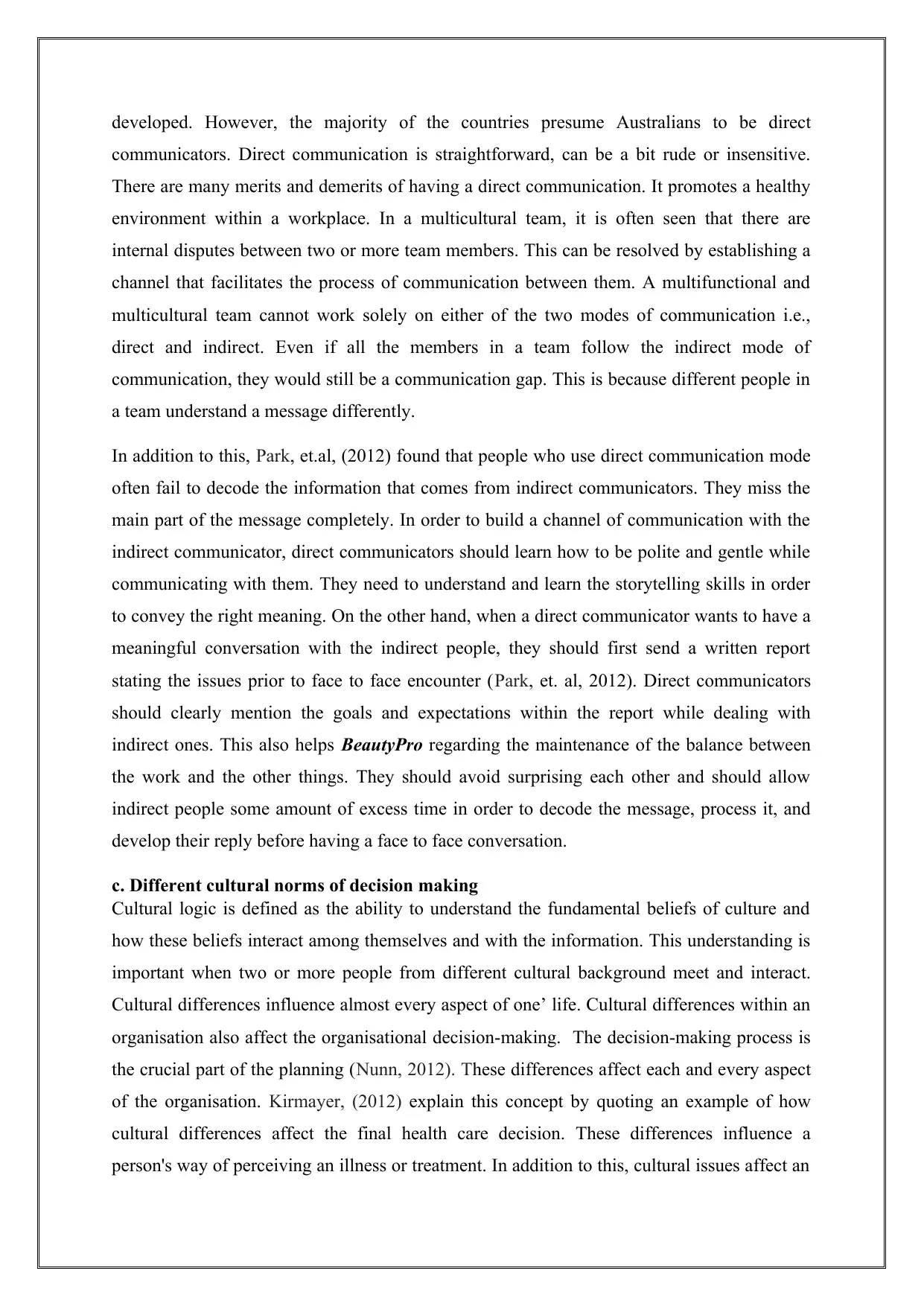
developed. However, the majority of the countries presume Australians to be direct
communicators. Direct communication is straightforward, can be a bit rude or insensitive.
There are many merits and demerits of having a direct communication. It promotes a healthy
environment within a workplace. In a multicultural team, it is often seen that there are
internal disputes between two or more team members. This can be resolved by establishing a
channel that facilitates the process of communication between them. A multifunctional and
multicultural team cannot work solely on either of the two modes of communication i.e.,
direct and indirect. Even if all the members in a team follow the indirect mode of
communication, they would still be a communication gap. This is because different people in
a team understand a message differently.
In addition to this, Park, et.al, (2012) found that people who use direct communication mode
often fail to decode the information that comes from indirect communicators. They miss the
main part of the message completely. In order to build a channel of communication with the
indirect communicator, direct communicators should learn how to be polite and gentle while
communicating with them. They need to understand and learn the storytelling skills in order
to convey the right meaning. On the other hand, when a direct communicator wants to have a
meaningful conversation with the indirect people, they should first send a written report
stating the issues prior to face to face encounter (Park, et. al, 2012). Direct communicators
should clearly mention the goals and expectations within the report while dealing with
indirect ones. This also helps BeautyPro regarding the maintenance of the balance between
the work and the other things. They should avoid surprising each other and should allow
indirect people some amount of excess time in order to decode the message, process it, and
develop their reply before having a face to face conversation.
c. Different cultural norms of decision making
Cultural logic is defined as the ability to understand the fundamental beliefs of culture and
how these beliefs interact among themselves and with the information. This understanding is
important when two or more people from different cultural background meet and interact.
Cultural differences influence almost every aspect of one’ life. Cultural differences within an
organisation also affect the organisational decision-making. The decision-making process is
the crucial part of the planning (Nunn, 2012). These differences affect each and every aspect
of the organisation. Kirmayer, (2012) explain this concept by quoting an example of how
cultural differences affect the final health care decision. These differences influence a
person's way of perceiving an illness or treatment. In addition to this, cultural issues affect an
communicators. Direct communication is straightforward, can be a bit rude or insensitive.
There are many merits and demerits of having a direct communication. It promotes a healthy
environment within a workplace. In a multicultural team, it is often seen that there are
internal disputes between two or more team members. This can be resolved by establishing a
channel that facilitates the process of communication between them. A multifunctional and
multicultural team cannot work solely on either of the two modes of communication i.e.,
direct and indirect. Even if all the members in a team follow the indirect mode of
communication, they would still be a communication gap. This is because different people in
a team understand a message differently.
In addition to this, Park, et.al, (2012) found that people who use direct communication mode
often fail to decode the information that comes from indirect communicators. They miss the
main part of the message completely. In order to build a channel of communication with the
indirect communicator, direct communicators should learn how to be polite and gentle while
communicating with them. They need to understand and learn the storytelling skills in order
to convey the right meaning. On the other hand, when a direct communicator wants to have a
meaningful conversation with the indirect people, they should first send a written report
stating the issues prior to face to face encounter (Park, et. al, 2012). Direct communicators
should clearly mention the goals and expectations within the report while dealing with
indirect ones. This also helps BeautyPro regarding the maintenance of the balance between
the work and the other things. They should avoid surprising each other and should allow
indirect people some amount of excess time in order to decode the message, process it, and
develop their reply before having a face to face conversation.
c. Different cultural norms of decision making
Cultural logic is defined as the ability to understand the fundamental beliefs of culture and
how these beliefs interact among themselves and with the information. This understanding is
important when two or more people from different cultural background meet and interact.
Cultural differences influence almost every aspect of one’ life. Cultural differences within an
organisation also affect the organisational decision-making. The decision-making process is
the crucial part of the planning (Nunn, 2012). These differences affect each and every aspect
of the organisation. Kirmayer, (2012) explain this concept by quoting an example of how
cultural differences affect the final health care decision. These differences influence a
person's way of perceiving an illness or treatment. In addition to this, cultural issues affect an
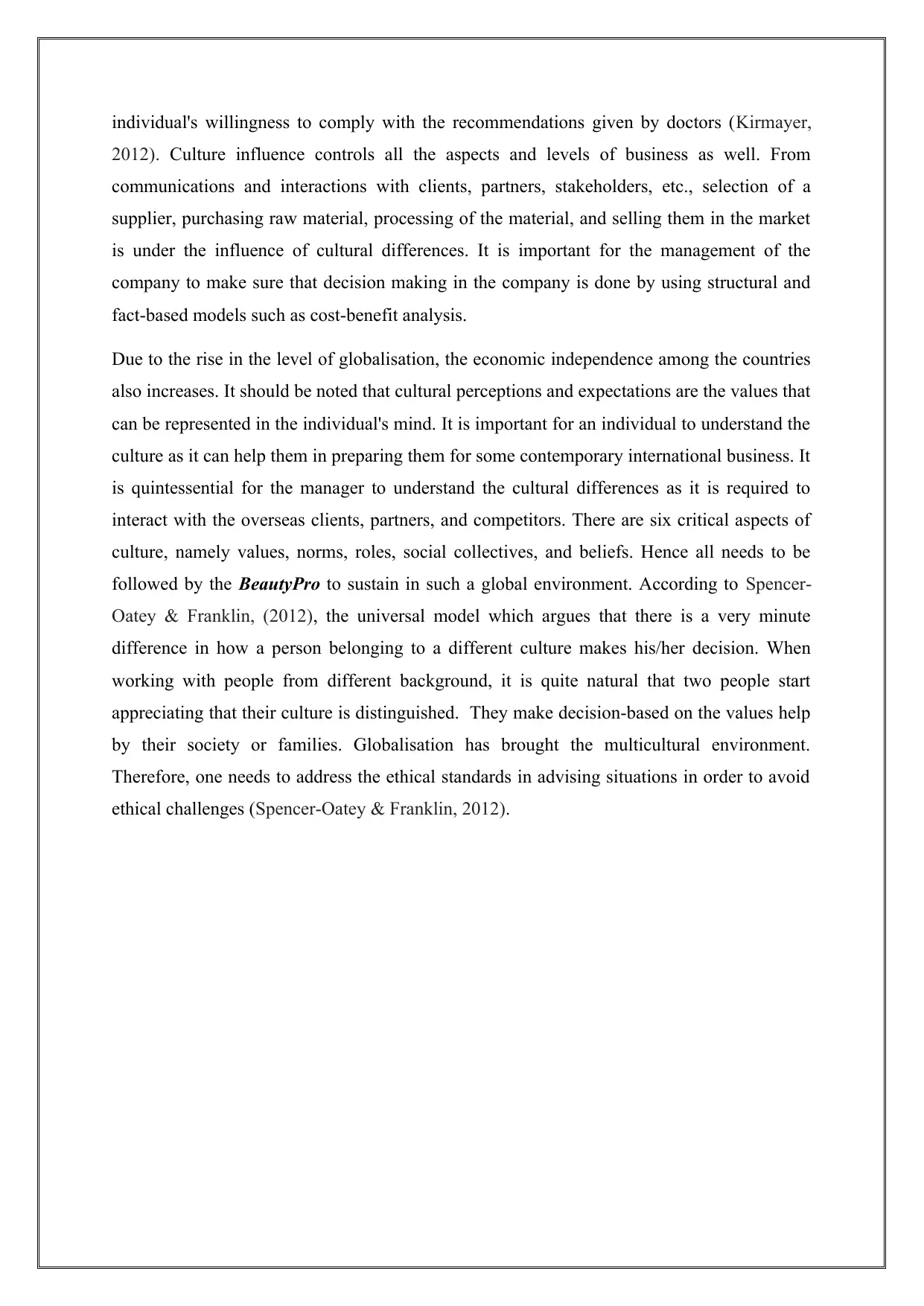
individual's willingness to comply with the recommendations given by doctors (Kirmayer,
2012). Culture influence controls all the aspects and levels of business as well. From
communications and interactions with clients, partners, stakeholders, etc., selection of a
supplier, purchasing raw material, processing of the material, and selling them in the market
is under the influence of cultural differences. It is important for the management of the
company to make sure that decision making in the company is done by using structural and
fact-based models such as cost-benefit analysis.
Due to the rise in the level of globalisation, the economic independence among the countries
also increases. It should be noted that cultural perceptions and expectations are the values that
can be represented in the individual's mind. It is important for an individual to understand the
culture as it can help them in preparing them for some contemporary international business. It
is quintessential for the manager to understand the cultural differences as it is required to
interact with the overseas clients, partners, and competitors. There are six critical aspects of
culture, namely values, norms, roles, social collectives, and beliefs. Hence all needs to be
followed by the BeautyPro to sustain in such a global environment. According to Spencer-
Oatey & Franklin, (2012), the universal model which argues that there is a very minute
difference in how a person belonging to a different culture makes his/her decision. When
working with people from different background, it is quite natural that two people start
appreciating that their culture is distinguished. They make decision-based on the values help
by their society or families. Globalisation has brought the multicultural environment.
Therefore, one needs to address the ethical standards in advising situations in order to avoid
ethical challenges (Spencer-Oatey & Franklin, 2012).
2012). Culture influence controls all the aspects and levels of business as well. From
communications and interactions with clients, partners, stakeholders, etc., selection of a
supplier, purchasing raw material, processing of the material, and selling them in the market
is under the influence of cultural differences. It is important for the management of the
company to make sure that decision making in the company is done by using structural and
fact-based models such as cost-benefit analysis.
Due to the rise in the level of globalisation, the economic independence among the countries
also increases. It should be noted that cultural perceptions and expectations are the values that
can be represented in the individual's mind. It is important for an individual to understand the
culture as it can help them in preparing them for some contemporary international business. It
is quintessential for the manager to understand the cultural differences as it is required to
interact with the overseas clients, partners, and competitors. There are six critical aspects of
culture, namely values, norms, roles, social collectives, and beliefs. Hence all needs to be
followed by the BeautyPro to sustain in such a global environment. According to Spencer-
Oatey & Franklin, (2012), the universal model which argues that there is a very minute
difference in how a person belonging to a different culture makes his/her decision. When
working with people from different background, it is quite natural that two people start
appreciating that their culture is distinguished. They make decision-based on the values help
by their society or families. Globalisation has brought the multicultural environment.
Therefore, one needs to address the ethical standards in advising situations in order to avoid
ethical challenges (Spencer-Oatey & Franklin, 2012).
Paraphrase This Document
Need a fresh take? Get an instant paraphrase of this document with our AI Paraphraser
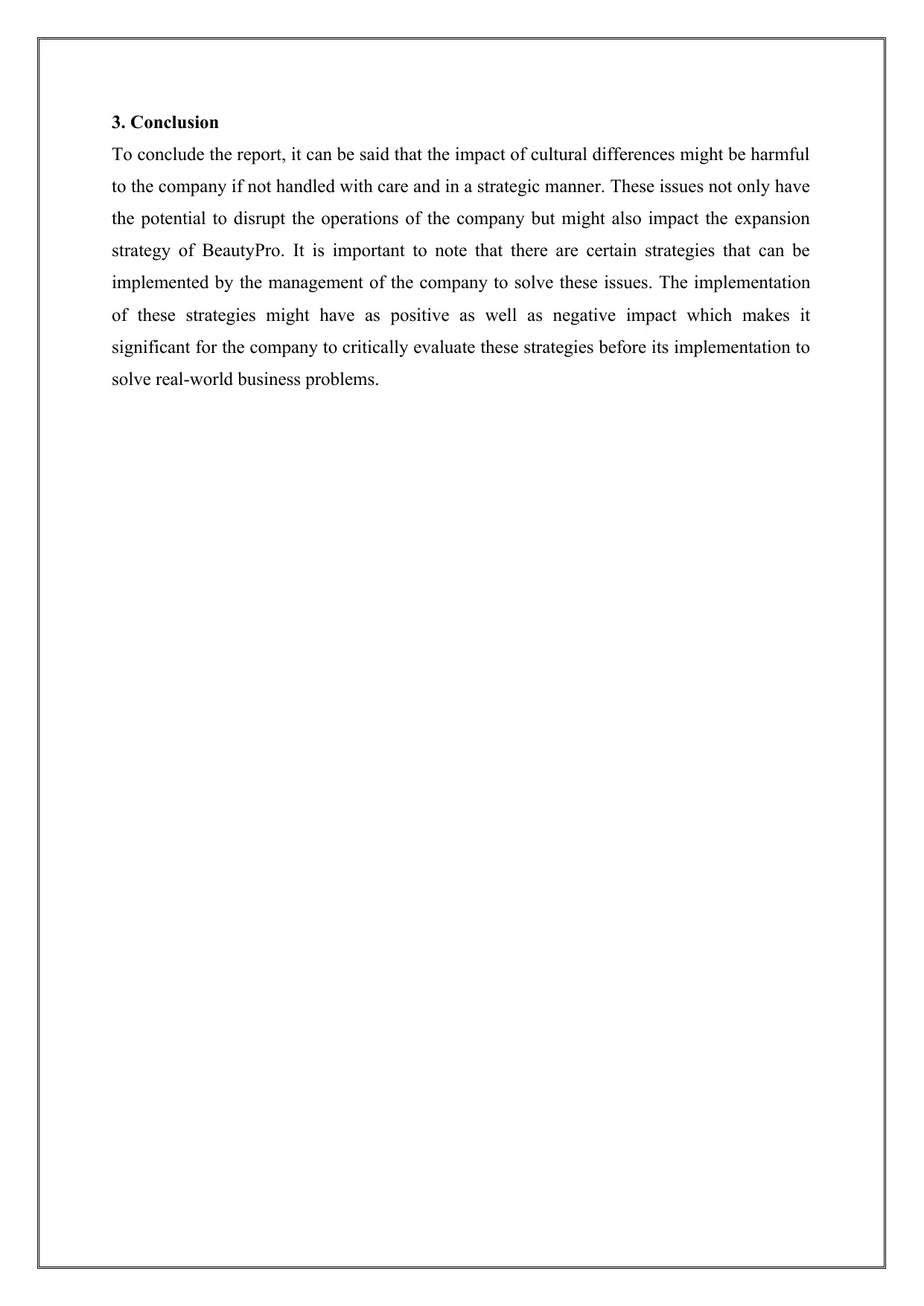
3. Conclusion
To conclude the report, it can be said that the impact of cultural differences might be harmful
to the company if not handled with care and in a strategic manner. These issues not only have
the potential to disrupt the operations of the company but might also impact the expansion
strategy of BeautyPro. It is important to note that there are certain strategies that can be
implemented by the management of the company to solve these issues. The implementation
of these strategies might have as positive as well as negative impact which makes it
significant for the company to critically evaluate these strategies before its implementation to
solve real-world business problems.
To conclude the report, it can be said that the impact of cultural differences might be harmful
to the company if not handled with care and in a strategic manner. These issues not only have
the potential to disrupt the operations of the company but might also impact the expansion
strategy of BeautyPro. It is important to note that there are certain strategies that can be
implemented by the management of the company to solve these issues. The implementation
of these strategies might have as positive as well as negative impact which makes it
significant for the company to critically evaluate these strategies before its implementation to
solve real-world business problems.
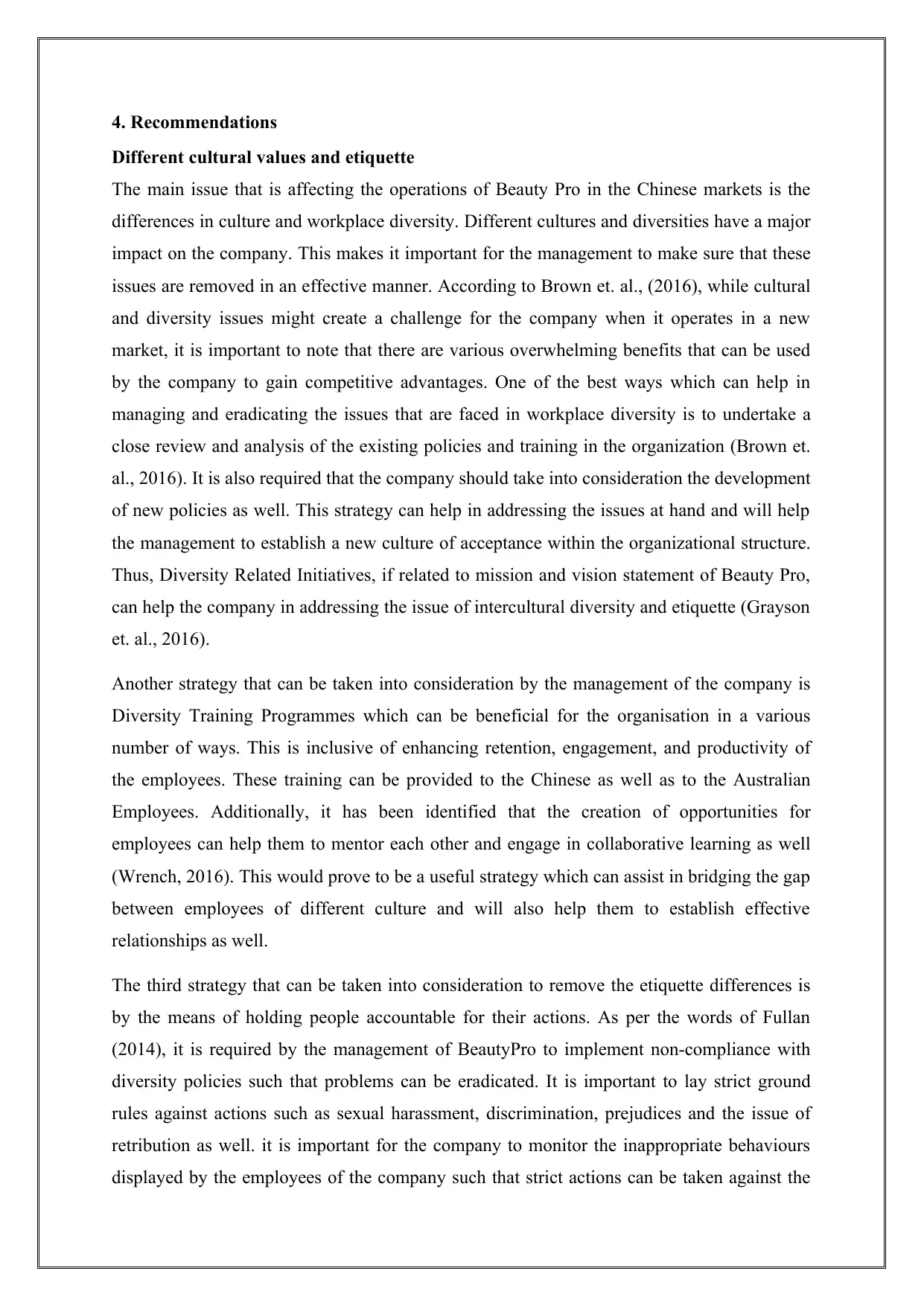
4. Recommendations
Different cultural values and etiquette
The main issue that is affecting the operations of Beauty Pro in the Chinese markets is the
differences in culture and workplace diversity. Different cultures and diversities have a major
impact on the company. This makes it important for the management to make sure that these
issues are removed in an effective manner. According to Brown et. al., (2016), while cultural
and diversity issues might create a challenge for the company when it operates in a new
market, it is important to note that there are various overwhelming benefits that can be used
by the company to gain competitive advantages. One of the best ways which can help in
managing and eradicating the issues that are faced in workplace diversity is to undertake a
close review and analysis of the existing policies and training in the organization (Brown et.
al., 2016). It is also required that the company should take into consideration the development
of new policies as well. This strategy can help in addressing the issues at hand and will help
the management to establish a new culture of acceptance within the organizational structure.
Thus, Diversity Related Initiatives, if related to mission and vision statement of Beauty Pro,
can help the company in addressing the issue of intercultural diversity and etiquette (Grayson
et. al., 2016).
Another strategy that can be taken into consideration by the management of the company is
Diversity Training Programmes which can be beneficial for the organisation in a various
number of ways. This is inclusive of enhancing retention, engagement, and productivity of
the employees. These training can be provided to the Chinese as well as to the Australian
Employees. Additionally, it has been identified that the creation of opportunities for
employees can help them to mentor each other and engage in collaborative learning as well
(Wrench, 2016). This would prove to be a useful strategy which can assist in bridging the gap
between employees of different culture and will also help them to establish effective
relationships as well.
The third strategy that can be taken into consideration to remove the etiquette differences is
by the means of holding people accountable for their actions. As per the words of Fullan
(2014), it is required by the management of BeautyPro to implement non-compliance with
diversity policies such that problems can be eradicated. It is important to lay strict ground
rules against actions such as sexual harassment, discrimination, prejudices and the issue of
retribution as well. it is important for the company to monitor the inappropriate behaviours
displayed by the employees of the company such that strict actions can be taken against the
Different cultural values and etiquette
The main issue that is affecting the operations of Beauty Pro in the Chinese markets is the
differences in culture and workplace diversity. Different cultures and diversities have a major
impact on the company. This makes it important for the management to make sure that these
issues are removed in an effective manner. According to Brown et. al., (2016), while cultural
and diversity issues might create a challenge for the company when it operates in a new
market, it is important to note that there are various overwhelming benefits that can be used
by the company to gain competitive advantages. One of the best ways which can help in
managing and eradicating the issues that are faced in workplace diversity is to undertake a
close review and analysis of the existing policies and training in the organization (Brown et.
al., 2016). It is also required that the company should take into consideration the development
of new policies as well. This strategy can help in addressing the issues at hand and will help
the management to establish a new culture of acceptance within the organizational structure.
Thus, Diversity Related Initiatives, if related to mission and vision statement of Beauty Pro,
can help the company in addressing the issue of intercultural diversity and etiquette (Grayson
et. al., 2016).
Another strategy that can be taken into consideration by the management of the company is
Diversity Training Programmes which can be beneficial for the organisation in a various
number of ways. This is inclusive of enhancing retention, engagement, and productivity of
the employees. These training can be provided to the Chinese as well as to the Australian
Employees. Additionally, it has been identified that the creation of opportunities for
employees can help them to mentor each other and engage in collaborative learning as well
(Wrench, 2016). This would prove to be a useful strategy which can assist in bridging the gap
between employees of different culture and will also help them to establish effective
relationships as well.
The third strategy that can be taken into consideration to remove the etiquette differences is
by the means of holding people accountable for their actions. As per the words of Fullan
(2014), it is required by the management of BeautyPro to implement non-compliance with
diversity policies such that problems can be eradicated. It is important to lay strict ground
rules against actions such as sexual harassment, discrimination, prejudices and the issue of
retribution as well. it is important for the company to monitor the inappropriate behaviours
displayed by the employees of the company such that strict actions can be taken against the
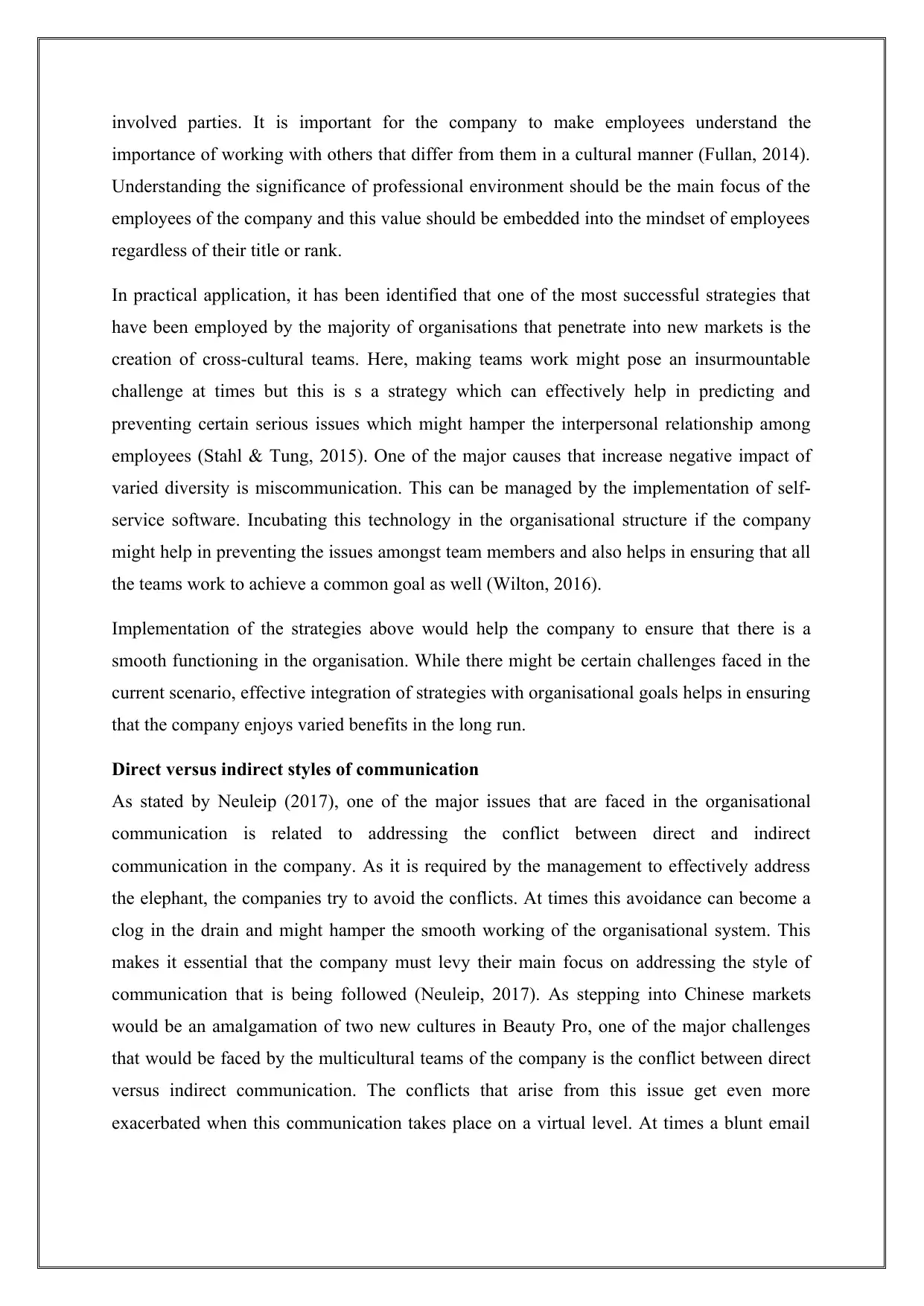
involved parties. It is important for the company to make employees understand the
importance of working with others that differ from them in a cultural manner (Fullan, 2014).
Understanding the significance of professional environment should be the main focus of the
employees of the company and this value should be embedded into the mindset of employees
regardless of their title or rank.
In practical application, it has been identified that one of the most successful strategies that
have been employed by the majority of organisations that penetrate into new markets is the
creation of cross-cultural teams. Here, making teams work might pose an insurmountable
challenge at times but this is s a strategy which can effectively help in predicting and
preventing certain serious issues which might hamper the interpersonal relationship among
employees (Stahl & Tung, 2015). One of the major causes that increase negative impact of
varied diversity is miscommunication. This can be managed by the implementation of self-
service software. Incubating this technology in the organisational structure if the company
might help in preventing the issues amongst team members and also helps in ensuring that all
the teams work to achieve a common goal as well (Wilton, 2016).
Implementation of the strategies above would help the company to ensure that there is a
smooth functioning in the organisation. While there might be certain challenges faced in the
current scenario, effective integration of strategies with organisational goals helps in ensuring
that the company enjoys varied benefits in the long run.
Direct versus indirect styles of communication
As stated by Neuleip (2017), one of the major issues that are faced in the organisational
communication is related to addressing the conflict between direct and indirect
communication in the company. As it is required by the management to effectively address
the elephant, the companies try to avoid the conflicts. At times this avoidance can become a
clog in the drain and might hamper the smooth working of the organisational system. This
makes it essential that the company must levy their main focus on addressing the style of
communication that is being followed (Neuleip, 2017). As stepping into Chinese markets
would be an amalgamation of two new cultures in Beauty Pro, one of the major challenges
that would be faced by the multicultural teams of the company is the conflict between direct
versus indirect communication. The conflicts that arise from this issue get even more
exacerbated when this communication takes place on a virtual level. At times a blunt email
importance of working with others that differ from them in a cultural manner (Fullan, 2014).
Understanding the significance of professional environment should be the main focus of the
employees of the company and this value should be embedded into the mindset of employees
regardless of their title or rank.
In practical application, it has been identified that one of the most successful strategies that
have been employed by the majority of organisations that penetrate into new markets is the
creation of cross-cultural teams. Here, making teams work might pose an insurmountable
challenge at times but this is s a strategy which can effectively help in predicting and
preventing certain serious issues which might hamper the interpersonal relationship among
employees (Stahl & Tung, 2015). One of the major causes that increase negative impact of
varied diversity is miscommunication. This can be managed by the implementation of self-
service software. Incubating this technology in the organisational structure if the company
might help in preventing the issues amongst team members and also helps in ensuring that all
the teams work to achieve a common goal as well (Wilton, 2016).
Implementation of the strategies above would help the company to ensure that there is a
smooth functioning in the organisation. While there might be certain challenges faced in the
current scenario, effective integration of strategies with organisational goals helps in ensuring
that the company enjoys varied benefits in the long run.
Direct versus indirect styles of communication
As stated by Neuleip (2017), one of the major issues that are faced in the organisational
communication is related to addressing the conflict between direct and indirect
communication in the company. As it is required by the management to effectively address
the elephant, the companies try to avoid the conflicts. At times this avoidance can become a
clog in the drain and might hamper the smooth working of the organisational system. This
makes it essential that the company must levy their main focus on addressing the style of
communication that is being followed (Neuleip, 2017). As stepping into Chinese markets
would be an amalgamation of two new cultures in Beauty Pro, one of the major challenges
that would be faced by the multicultural teams of the company is the conflict between direct
versus indirect communication. The conflicts that arise from this issue get even more
exacerbated when this communication takes place on a virtual level. At times a blunt email
Secure Best Marks with AI Grader
Need help grading? Try our AI Grader for instant feedback on your assignments.
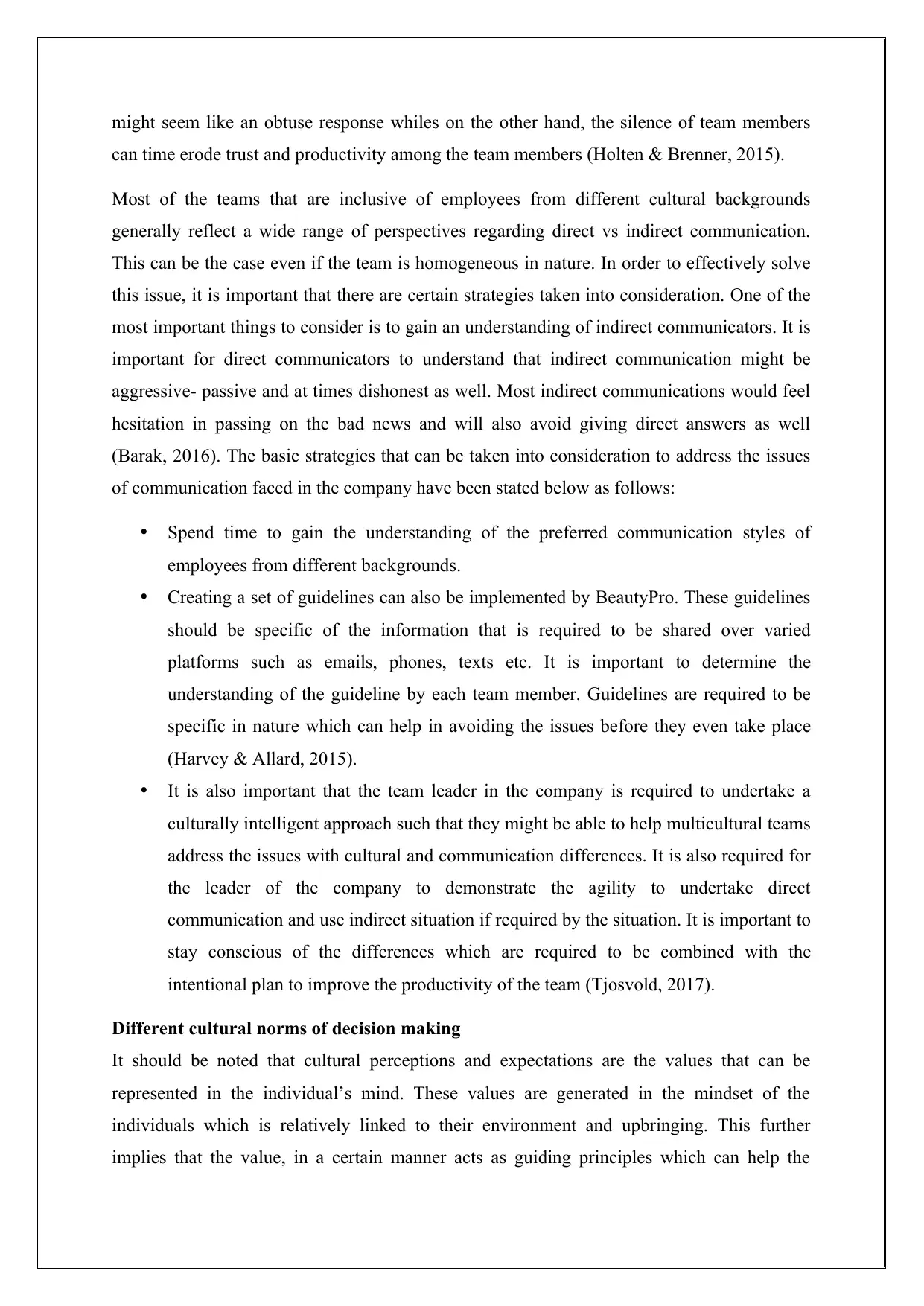
might seem like an obtuse response whiles on the other hand, the silence of team members
can time erode trust and productivity among the team members (Holten & Brenner, 2015).
Most of the teams that are inclusive of employees from different cultural backgrounds
generally reflect a wide range of perspectives regarding direct vs indirect communication.
This can be the case even if the team is homogeneous in nature. In order to effectively solve
this issue, it is important that there are certain strategies taken into consideration. One of the
most important things to consider is to gain an understanding of indirect communicators. It is
important for direct communicators to understand that indirect communication might be
aggressive- passive and at times dishonest as well. Most indirect communications would feel
hesitation in passing on the bad news and will also avoid giving direct answers as well
(Barak, 2016). The basic strategies that can be taken into consideration to address the issues
of communication faced in the company have been stated below as follows:
Spend time to gain the understanding of the preferred communication styles of
employees from different backgrounds.
Creating a set of guidelines can also be implemented by BeautyPro. These guidelines
should be specific of the information that is required to be shared over varied
platforms such as emails, phones, texts etc. It is important to determine the
understanding of the guideline by each team member. Guidelines are required to be
specific in nature which can help in avoiding the issues before they even take place
(Harvey & Allard, 2015).
It is also important that the team leader in the company is required to undertake a
culturally intelligent approach such that they might be able to help multicultural teams
address the issues with cultural and communication differences. It is also required for
the leader of the company to demonstrate the agility to undertake direct
communication and use indirect situation if required by the situation. It is important to
stay conscious of the differences which are required to be combined with the
intentional plan to improve the productivity of the team (Tjosvold, 2017).
Different cultural norms of decision making
It should be noted that cultural perceptions and expectations are the values that can be
represented in the individual’s mind. These values are generated in the mindset of the
individuals which is relatively linked to their environment and upbringing. This further
implies that the value, in a certain manner acts as guiding principles which can help the
can time erode trust and productivity among the team members (Holten & Brenner, 2015).
Most of the teams that are inclusive of employees from different cultural backgrounds
generally reflect a wide range of perspectives regarding direct vs indirect communication.
This can be the case even if the team is homogeneous in nature. In order to effectively solve
this issue, it is important that there are certain strategies taken into consideration. One of the
most important things to consider is to gain an understanding of indirect communicators. It is
important for direct communicators to understand that indirect communication might be
aggressive- passive and at times dishonest as well. Most indirect communications would feel
hesitation in passing on the bad news and will also avoid giving direct answers as well
(Barak, 2016). The basic strategies that can be taken into consideration to address the issues
of communication faced in the company have been stated below as follows:
Spend time to gain the understanding of the preferred communication styles of
employees from different backgrounds.
Creating a set of guidelines can also be implemented by BeautyPro. These guidelines
should be specific of the information that is required to be shared over varied
platforms such as emails, phones, texts etc. It is important to determine the
understanding of the guideline by each team member. Guidelines are required to be
specific in nature which can help in avoiding the issues before they even take place
(Harvey & Allard, 2015).
It is also important that the team leader in the company is required to undertake a
culturally intelligent approach such that they might be able to help multicultural teams
address the issues with cultural and communication differences. It is also required for
the leader of the company to demonstrate the agility to undertake direct
communication and use indirect situation if required by the situation. It is important to
stay conscious of the differences which are required to be combined with the
intentional plan to improve the productivity of the team (Tjosvold, 2017).
Different cultural norms of decision making
It should be noted that cultural perceptions and expectations are the values that can be
represented in the individual’s mind. These values are generated in the mindset of the
individuals which is relatively linked to their environment and upbringing. This further
implies that the value, in a certain manner acts as guiding principles which can help the
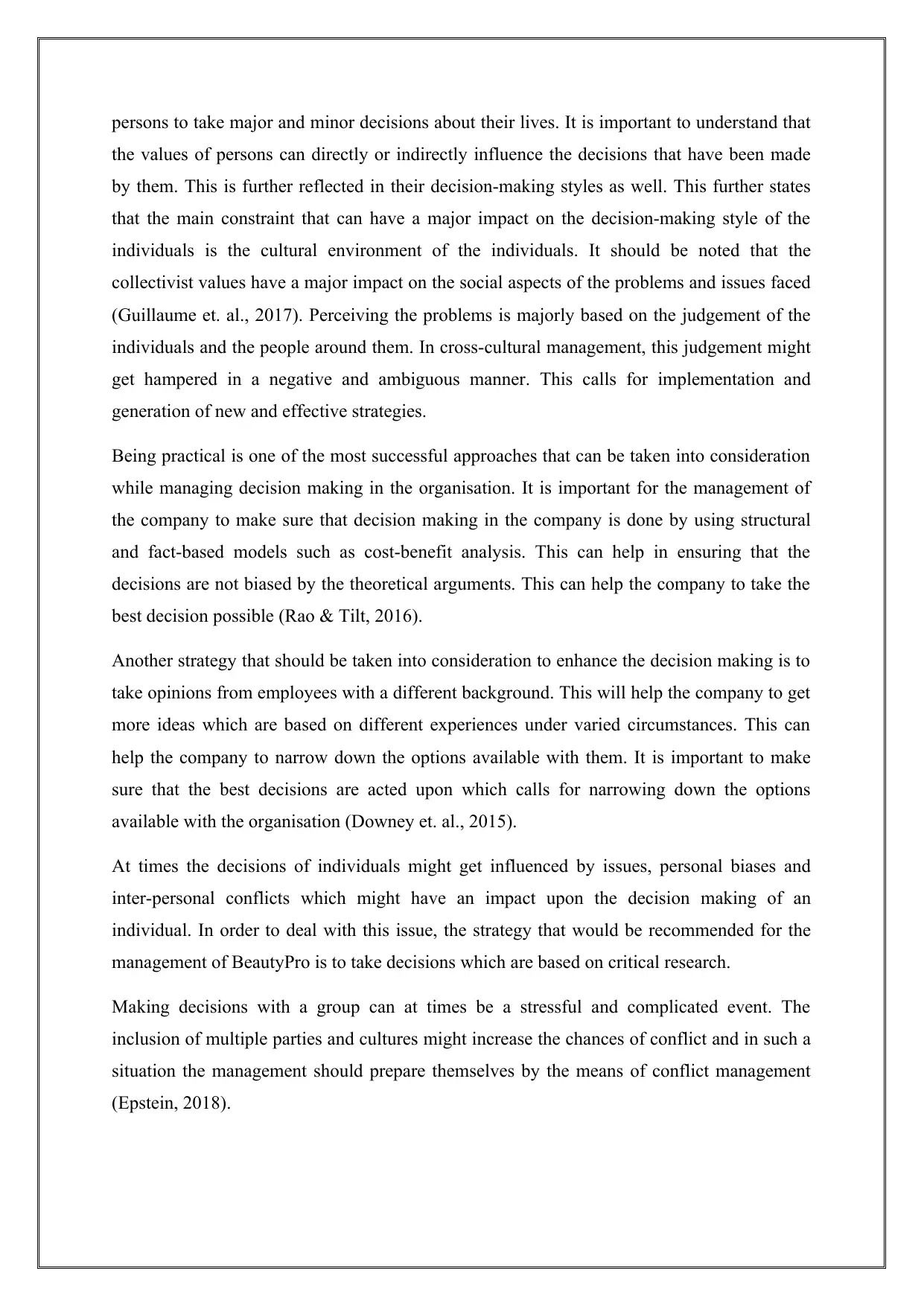
persons to take major and minor decisions about their lives. It is important to understand that
the values of persons can directly or indirectly influence the decisions that have been made
by them. This is further reflected in their decision-making styles as well. This further states
that the main constraint that can have a major impact on the decision-making style of the
individuals is the cultural environment of the individuals. It should be noted that the
collectivist values have a major impact on the social aspects of the problems and issues faced
(Guillaume et. al., 2017). Perceiving the problems is majorly based on the judgement of the
individuals and the people around them. In cross-cultural management, this judgement might
get hampered in a negative and ambiguous manner. This calls for implementation and
generation of new and effective strategies.
Being practical is one of the most successful approaches that can be taken into consideration
while managing decision making in the organisation. It is important for the management of
the company to make sure that decision making in the company is done by using structural
and fact-based models such as cost-benefit analysis. This can help in ensuring that the
decisions are not biased by the theoretical arguments. This can help the company to take the
best decision possible (Rao & Tilt, 2016).
Another strategy that should be taken into consideration to enhance the decision making is to
take opinions from employees with a different background. This will help the company to get
more ideas which are based on different experiences under varied circumstances. This can
help the company to narrow down the options available with them. It is important to make
sure that the best decisions are acted upon which calls for narrowing down the options
available with the organisation (Downey et. al., 2015).
At times the decisions of individuals might get influenced by issues, personal biases and
inter-personal conflicts which might have an impact upon the decision making of an
individual. In order to deal with this issue, the strategy that would be recommended for the
management of BeautyPro is to take decisions which are based on critical research.
Making decisions with a group can at times be a stressful and complicated event. The
inclusion of multiple parties and cultures might increase the chances of conflict and in such a
situation the management should prepare themselves by the means of conflict management
(Epstein, 2018).
the values of persons can directly or indirectly influence the decisions that have been made
by them. This is further reflected in their decision-making styles as well. This further states
that the main constraint that can have a major impact on the decision-making style of the
individuals is the cultural environment of the individuals. It should be noted that the
collectivist values have a major impact on the social aspects of the problems and issues faced
(Guillaume et. al., 2017). Perceiving the problems is majorly based on the judgement of the
individuals and the people around them. In cross-cultural management, this judgement might
get hampered in a negative and ambiguous manner. This calls for implementation and
generation of new and effective strategies.
Being practical is one of the most successful approaches that can be taken into consideration
while managing decision making in the organisation. It is important for the management of
the company to make sure that decision making in the company is done by using structural
and fact-based models such as cost-benefit analysis. This can help in ensuring that the
decisions are not biased by the theoretical arguments. This can help the company to take the
best decision possible (Rao & Tilt, 2016).
Another strategy that should be taken into consideration to enhance the decision making is to
take opinions from employees with a different background. This will help the company to get
more ideas which are based on different experiences under varied circumstances. This can
help the company to narrow down the options available with them. It is important to make
sure that the best decisions are acted upon which calls for narrowing down the options
available with the organisation (Downey et. al., 2015).
At times the decisions of individuals might get influenced by issues, personal biases and
inter-personal conflicts which might have an impact upon the decision making of an
individual. In order to deal with this issue, the strategy that would be recommended for the
management of BeautyPro is to take decisions which are based on critical research.
Making decisions with a group can at times be a stressful and complicated event. The
inclusion of multiple parties and cultures might increase the chances of conflict and in such a
situation the management should prepare themselves by the means of conflict management
(Epstein, 2018).
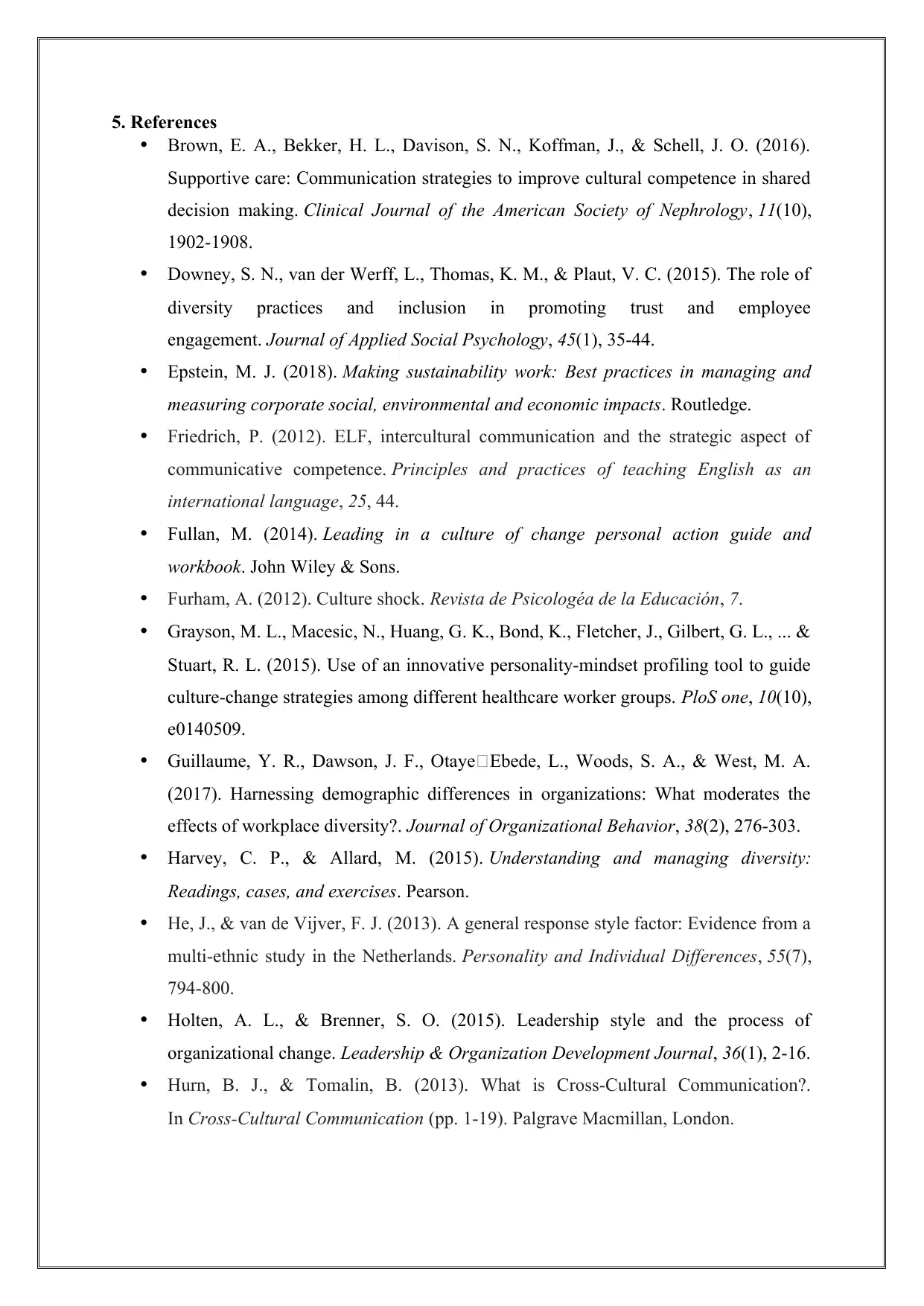
5. References
Brown, E. A., Bekker, H. L., Davison, S. N., Koffman, J., & Schell, J. O. (2016).
Supportive care: Communication strategies to improve cultural competence in shared
decision making. Clinical Journal of the American Society of Nephrology, 11(10),
1902-1908.
Downey, S. N., van der Werff, L., Thomas, K. M., & Plaut, V. C. (2015). The role of
diversity practices and inclusion in promoting trust and employee
engagement. Journal of Applied Social Psychology, 45(1), 35-44.
Epstein, M. J. (2018). Making sustainability work: Best practices in managing and
measuring corporate social, environmental and economic impacts. Routledge.
Friedrich, P. (2012). ELF, intercultural communication and the strategic aspect of
communicative competence. Principles and practices of teaching English as an
international language, 25, 44.
Fullan, M. (2014). Leading in a culture of change personal action guide and
workbook. John Wiley & Sons.
Furham, A. (2012). Culture shock. Revista de Psicologéa de la Educación, 7.
Grayson, M. L., Macesic, N., Huang, G. K., Bond, K., Fletcher, J., Gilbert, G. L., ... &
Stuart, R. L. (2015). Use of an innovative personality-mindset profiling tool to guide
culture-change strategies among different healthcare worker groups. PloS one, 10(10),
e0140509.
Guillaume, Y. R., Dawson, J. F., Otaye‐Ebede, L., Woods, S. A., & West, M. A.
(2017). Harnessing demographic differences in organizations: What moderates the
effects of workplace diversity?. Journal of Organizational Behavior, 38(2), 276-303.
Harvey, C. P., & Allard, M. (2015). Understanding and managing diversity:
Readings, cases, and exercises. Pearson.
He, J., & van de Vijver, F. J. (2013). A general response style factor: Evidence from a
multi-ethnic study in the Netherlands. Personality and Individual Differences, 55(7),
794-800.
Holten, A. L., & Brenner, S. O. (2015). Leadership style and the process of
organizational change. Leadership & Organization Development Journal, 36(1), 2-16.
Hurn, B. J., & Tomalin, B. (2013). What is Cross-Cultural Communication?.
In Cross-Cultural Communication (pp. 1-19). Palgrave Macmillan, London.
Brown, E. A., Bekker, H. L., Davison, S. N., Koffman, J., & Schell, J. O. (2016).
Supportive care: Communication strategies to improve cultural competence in shared
decision making. Clinical Journal of the American Society of Nephrology, 11(10),
1902-1908.
Downey, S. N., van der Werff, L., Thomas, K. M., & Plaut, V. C. (2015). The role of
diversity practices and inclusion in promoting trust and employee
engagement. Journal of Applied Social Psychology, 45(1), 35-44.
Epstein, M. J. (2018). Making sustainability work: Best practices in managing and
measuring corporate social, environmental and economic impacts. Routledge.
Friedrich, P. (2012). ELF, intercultural communication and the strategic aspect of
communicative competence. Principles and practices of teaching English as an
international language, 25, 44.
Fullan, M. (2014). Leading in a culture of change personal action guide and
workbook. John Wiley & Sons.
Furham, A. (2012). Culture shock. Revista de Psicologéa de la Educación, 7.
Grayson, M. L., Macesic, N., Huang, G. K., Bond, K., Fletcher, J., Gilbert, G. L., ... &
Stuart, R. L. (2015). Use of an innovative personality-mindset profiling tool to guide
culture-change strategies among different healthcare worker groups. PloS one, 10(10),
e0140509.
Guillaume, Y. R., Dawson, J. F., Otaye‐Ebede, L., Woods, S. A., & West, M. A.
(2017). Harnessing demographic differences in organizations: What moderates the
effects of workplace diversity?. Journal of Organizational Behavior, 38(2), 276-303.
Harvey, C. P., & Allard, M. (2015). Understanding and managing diversity:
Readings, cases, and exercises. Pearson.
He, J., & van de Vijver, F. J. (2013). A general response style factor: Evidence from a
multi-ethnic study in the Netherlands. Personality and Individual Differences, 55(7),
794-800.
Holten, A. L., & Brenner, S. O. (2015). Leadership style and the process of
organizational change. Leadership & Organization Development Journal, 36(1), 2-16.
Hurn, B. J., & Tomalin, B. (2013). What is Cross-Cultural Communication?.
In Cross-Cultural Communication (pp. 1-19). Palgrave Macmillan, London.
Paraphrase This Document
Need a fresh take? Get an instant paraphrase of this document with our AI Paraphraser
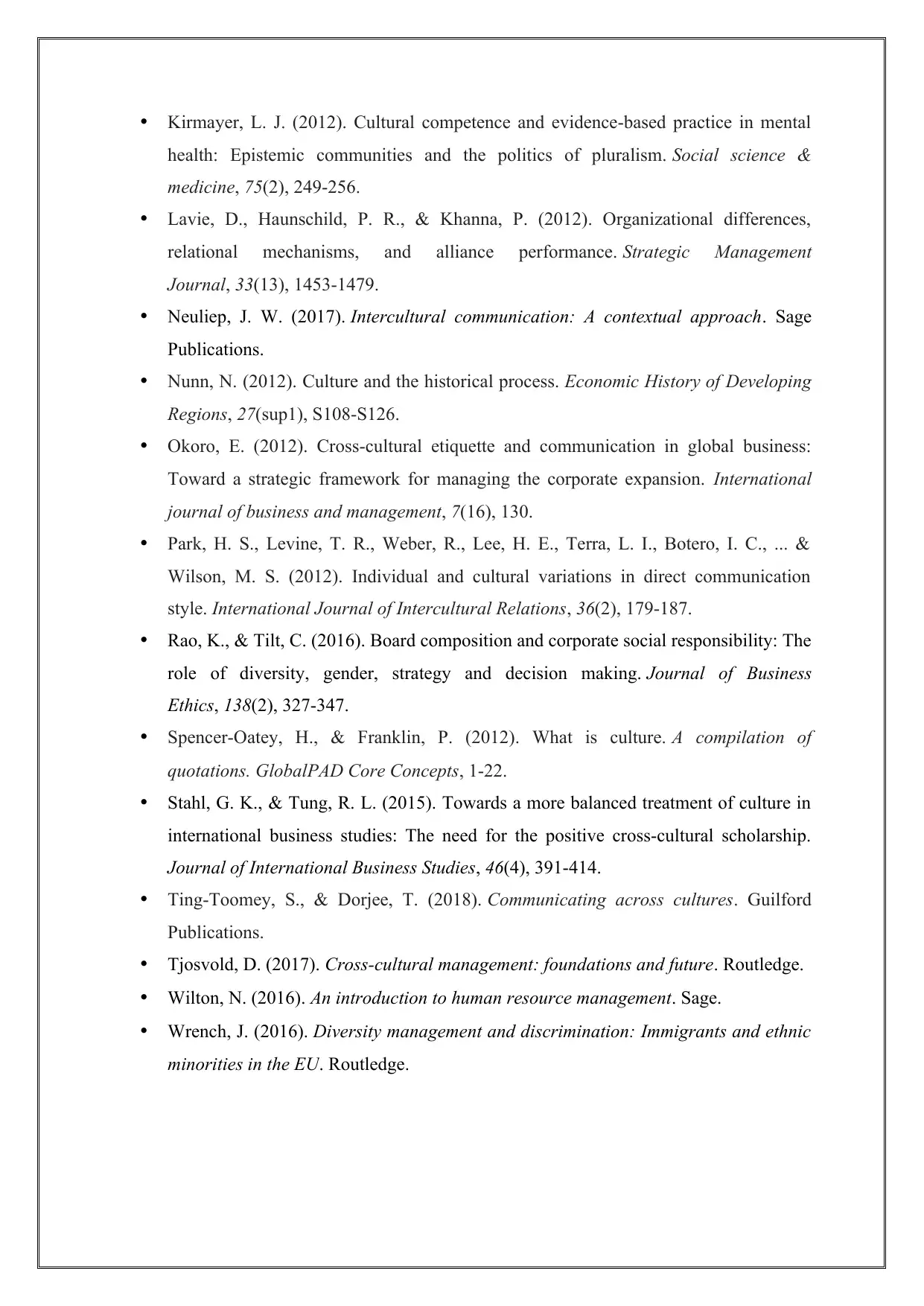
Kirmayer, L. J. (2012). Cultural competence and evidence-based practice in mental
health: Epistemic communities and the politics of pluralism. Social science &
medicine, 75(2), 249-256.
Lavie, D., Haunschild, P. R., & Khanna, P. (2012). Organizational differences,
relational mechanisms, and alliance performance. Strategic Management
Journal, 33(13), 1453-1479.
Neuliep, J. W. (2017). Intercultural communication: A contextual approach. Sage
Publications.
Nunn, N. (2012). Culture and the historical process. Economic History of Developing
Regions, 27(sup1), S108-S126.
Okoro, E. (2012). Cross-cultural etiquette and communication in global business:
Toward a strategic framework for managing the corporate expansion. International
journal of business and management, 7(16), 130.
Park, H. S., Levine, T. R., Weber, R., Lee, H. E., Terra, L. I., Botero, I. C., ... &
Wilson, M. S. (2012). Individual and cultural variations in direct communication
style. International Journal of Intercultural Relations, 36(2), 179-187.
Rao, K., & Tilt, C. (2016). Board composition and corporate social responsibility: The
role of diversity, gender, strategy and decision making. Journal of Business
Ethics, 138(2), 327-347.
Spencer-Oatey, H., & Franklin, P. (2012). What is culture. A compilation of
quotations. GlobalPAD Core Concepts, 1-22.
Stahl, G. K., & Tung, R. L. (2015). Towards a more balanced treatment of culture in
international business studies: The need for the positive cross-cultural scholarship.
Journal of International Business Studies, 46(4), 391-414.
Ting-Toomey, S., & Dorjee, T. (2018). Communicating across cultures. Guilford
Publications.
Tjosvold, D. (2017). Cross-cultural management: foundations and future. Routledge.
Wilton, N. (2016). An introduction to human resource management. Sage.
Wrench, J. (2016). Diversity management and discrimination: Immigrants and ethnic
minorities in the EU. Routledge.
health: Epistemic communities and the politics of pluralism. Social science &
medicine, 75(2), 249-256.
Lavie, D., Haunschild, P. R., & Khanna, P. (2012). Organizational differences,
relational mechanisms, and alliance performance. Strategic Management
Journal, 33(13), 1453-1479.
Neuliep, J. W. (2017). Intercultural communication: A contextual approach. Sage
Publications.
Nunn, N. (2012). Culture and the historical process. Economic History of Developing
Regions, 27(sup1), S108-S126.
Okoro, E. (2012). Cross-cultural etiquette and communication in global business:
Toward a strategic framework for managing the corporate expansion. International
journal of business and management, 7(16), 130.
Park, H. S., Levine, T. R., Weber, R., Lee, H. E., Terra, L. I., Botero, I. C., ... &
Wilson, M. S. (2012). Individual and cultural variations in direct communication
style. International Journal of Intercultural Relations, 36(2), 179-187.
Rao, K., & Tilt, C. (2016). Board composition and corporate social responsibility: The
role of diversity, gender, strategy and decision making. Journal of Business
Ethics, 138(2), 327-347.
Spencer-Oatey, H., & Franklin, P. (2012). What is culture. A compilation of
quotations. GlobalPAD Core Concepts, 1-22.
Stahl, G. K., & Tung, R. L. (2015). Towards a more balanced treatment of culture in
international business studies: The need for the positive cross-cultural scholarship.
Journal of International Business Studies, 46(4), 391-414.
Ting-Toomey, S., & Dorjee, T. (2018). Communicating across cultures. Guilford
Publications.
Tjosvold, D. (2017). Cross-cultural management: foundations and future. Routledge.
Wilton, N. (2016). An introduction to human resource management. Sage.
Wrench, J. (2016). Diversity management and discrimination: Immigrants and ethnic
minorities in the EU. Routledge.
1 out of 14
Related Documents
Your All-in-One AI-Powered Toolkit for Academic Success.
+13062052269
info@desklib.com
Available 24*7 on WhatsApp / Email
![[object Object]](/_next/static/media/star-bottom.7253800d.svg)
Unlock your academic potential
© 2024 | Zucol Services PVT LTD | All rights reserved.




